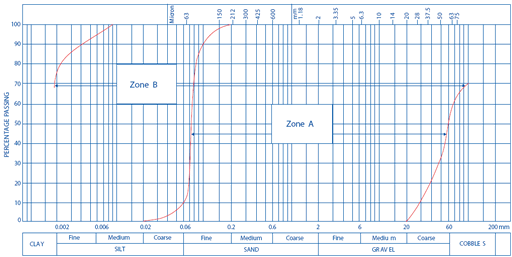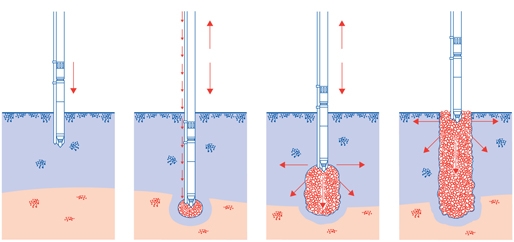4.6 Vibratory ground improvement techniques
| 4.6 - Appendix 4.6A | |
| Soil classification chart | |
| Vibratory techniques | |
| 4.6 - Appendix 4.6B | |
| Materials for use as fill | |
Appendix 4.6-A
SOIL CLASSIFICATION CHART
Conditions acceptable for treatment are only those within zones A and B of the chart.

Zone A Range of materials suitable for deep compaction (vibro-compaction) techniques
Zone B Range of materials suitable for stone column (vibro-replacement) techniques
Vibratory techniques
The vibratory process is applied usually to weak natural soils and filled ground. The purpose is to improve the load bearing capacity, reduce settlement and provide an adequate bearing stratum for the foundation supporting the dwelling.
A decision to buy a hazardous site is an acceptance by the builder/developer of the risks involved. It is important that the ground hazards are assessed before buying the site, and that allowance is made in foundation design for any consequences of this assessment.
Hazardous sites are defined in NHBC Rules.
ACCEPTABLE METHODS
There are two vibratory techniques commonly used in the UK. These are known as the 'dry bottom feed' and 'dry top feed' methods, and are illustrated. A third technique, infrequently used in the UK, and known as the 'wet bottom feed' method is also acceptable to NHBC. This method is not illustrated.
Dry bottom feed method
In weaker soils or situations where there is a high water table and the bore hole is liable to collapse between vibrator insertions, the dry bottom feed method is adopted. The vibrator penetrates by its mass, air flush and vibration, but at design depth the stone is introduced via a hopper into a pipe fixed to the side of a vibrator. The stone, usually of 40mm size, exits the pipe at the tip of the vibrator and in to the bottom of the bore hole. The stone is then compacted into the surrounding soil by repeated withdrawal and insertion of the vibrator.
Dry top feed method
In the dry top feed method the vibrator penetrates the weak soil or fill by its mass, air flush and vibration to form a bore hole. Once refusal or design depth is reached the vibrator is removed and stone fill introduced into the bore, the 'charge' is typically 500-800mm deep. The vibrator is re-inserted and 'packs' the stone into the surrounding strata. Successive charges of stone are added and compacted bringing the column up to working level. Typically the stone grading is 40-75mm.
Appendix 4.6-B
MATERIALS FOR USE AS FILL
Hazardous materials
The following materials require testing to ensure their suitability for use as fill to support structural foundations and slabs or as backfill to associated trenches:
- acid wastes
- reactive materials
- materials that include sulfates (eg gypsum)
- organic materials
- toxic materials
- materials that cause noxious fumes, rot, undue settlement or damage to surrounding materials.
Test requirements
Tests should be carried out by a suitably qualified person with a detailed knowledge of:
- the material to be tested, and
- the proposed conditions of use.
The samples tested must be representative of the true nature of the material. It may be necessary to take a number of samples to find out the material characteristics of the fill.
Sulfate content should be expressed as a percentage SO4 by weight on the basis of acid soluble testing, taking full account of the recommendations of BRE Special Digest 1 Part 1.
Sources of fill material
Where the material is of a stable and uniform type from one source, it may only be necessary to check its suitability once. If material is variable, or from a number of sources, it should all be suitable. Regular inspections and/or testing may be required.
Where material is obtained from stockpiles, check the material is uniform. Different forms of stockpiling can affect particle size/grading. The outside of a stockpile may be weathered and may not be the same as unweathered material.
The use of recycled aggregate as fill should comply with BRE Digest 433 or other suitable guidance as agreed with NHBC.
Fill requiring NHBC approval
The following types of fill should not be used unless written permission has been obtained from NHBC:
- colliery shale and any other residue from mineral extraction
- slags
- furnace ashes and other products of combustion
- material obtained from demolition
- on wet sites, or sites with a high water table, crushed or broken bricks which have no limit on their soluble salt content (as defined in BS EN 771).
Expansive materials
Fill containing expansive materials is not acceptable for use as support to structural foundations and slabs or as backfill to associated trenches.























